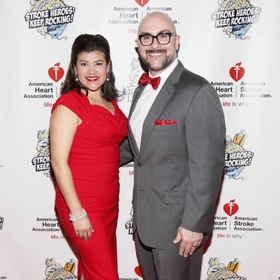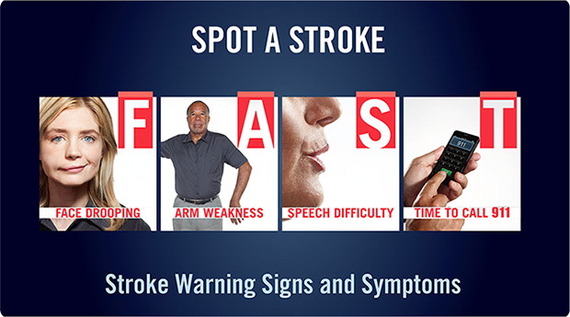As the lone person without medical training on the Mock Stroke Alert team at San Antonio's Baptist Medical Center, Erik Frederick got the only role that didn't need any expertise. He played the patient.
An administrator by trade, Erik took his acting gig seriously, practicing each of the primary stroke warning signs: face drooping, arm weakness and speech difficulty. Over dozens of drills, he mixed up which symptoms he pretended to be suffering to better challenge his colleagues.
The efforts paid off in spring 2009. His hospital, and the other four in its system, earned Primary Stroke Center status from the American Heart Association/American Stroke Association and The Joint Commission. This means the hospitals met standards to support better outcomes for stroke care.
Now flash forward to July 2010. Erik is the Director of Operations and his wife, Sonya, a nurse recruiter at Baptist Medical Center, have just finished teaching together a class in customer service and patient experience.
They're walking down the hallway near the admissions office when Sonya says, "I don't feel good." A nurse takes Sonya into an office. The emergency room director happens to walk by and Erik asks her to look at Sonya. While this impromptu exam is underway, Erik zips into his office to call Sonya's mom; whatever is happening, they're going to need her to pick up their kids from daycare.
Erik is still talking to his mother-in-law when the hospital's intercom blares: "Stroke alert! Admissions office!"
***
May is American Stroke Month, which makes this a great time to spotlight the No. 5 killer of Americans and a leading cause of long-term adult disability.
As you may recall from the survivor story told in this space a few weeks ago, strokes can interrupt anyone's life at any time. Amazing care and treatment are available, especially for folks fortunate enough to get treated right away. It's even more so for anyone getting immediate treatment at a Primary Stroke Center or a Comprehensive Stroke Center.
And what about someone having a stroke while already at a Primary Stroke Center? And that person being a nurse there, getting treated by her colleagues? And her husband oversaw the effort that turned the hospital into a Primary Stroke Center?
It almost seems made up. Then again, so does much else about the tale of Erik and Sonya Frederick.
***
Each says they knew the other was "the one" from the start.
They met at Baptist Medical Center, which is fitting for Sonya since she was born there and worked there for most of her career. Their paths crossed in a hallway in November 2005; each was smitten right away.
"My first couple of weeks at this job, I found myself a few times wondering what I'd gotten myself into," Erik said. "Then I saw her and I had this minute where I said, `Ohhhh.' I spoke to God a little and said, `So that's why I'm here.' I know it sounds cheesy, but it's true."
They married in October 2006. Both were in their 30s and wanted to start a family right away. When they had trouble conceiving, they began fertility treatments and became foster parents.
They eventually fostered 10 children. At the time of Sonya's stroke, they had two: Noah, who was 18 months old, and Emma, who was 11 months old.
Sonya also was supporting her parents with their health needs. Her dad suffered a stroke in 2000. He remains weak on his right side, has a speech impediment and lost some cognitive ability. Her mother also has had some heart issues, prompting doctors to implant a pacemaker in 2007.
As much as it pained her to see him suffer, what hurts more is the regret of not having recognized his stroke sooner. She'd been called to his house when he began slurring his speech and she let him rest for nearly two hours before calling 9-1-1. Despite her training as a nurse, and despite knowing his father had suffered a stroke, in the heat of the moment she played the role of the dutiful daughter, giving in when her stubborn, stoic dad refused to go to the hospital.
"I have always, always carried the guilt that I could've gotten him treatment to help him have a different outcome," she said. "I can never forgive myself for not doing more."
***
Now we're back to July 12, 2010, at Baptist Medical Center.
Sonya finds herself on a stretcher entering the CT scanner. "This can't be happening to me," she thinks. "I'm 42, I have babies at home and things to do. This is not where I'm supposed to be."
Then Erik takes her hand.
"Baby, I'm right here, he says. "I'll meet you in the ER."
Sonya is quickly moved from CT to Trauma 1 in the ER. The doctor asks Sonya to lift her arm; she can't. She asks Sonya to speak and then to smile; she can't. Colleagues rush in, hooking her up to IV fluids and oxygen.
Tears roll down Sonya's cheeks. Although she's unable to speak, her inner dialogue continues.
Sitting across the room, Erik envisions Sonya's father and grandfather, who also had a debilitating stroke, and wonders, "How am I going to deal with this?" Then his gaze refocuses; he watches the Stroke Team in action, working in harmony at this special skill for which they are so prepared ... the skill he helped coordinate during their preparation ... the one in which he used to be the patient.
"One moment I'm all panicky. And then I'm real calm," Erik says. "The team is doing all this stuff that we've worked on the last two years. It's working! I start to get proud.
"And then I realize again -- that's my wife."
***
Doctors determined that Sonya had suffered a series of mini-strokes known as TIAs, or transient ischemic attacks. In retrospect, she realized that she'd suffered another only a few days before. She'd been at a church function and wound up in the hospital. She'd been given anti-anxiety medication.
Doctors also discovered that Sonya had lived her entire life with a hole in her heart. Known as a patent foramen ovale, or PFO, it was later corrected through a surgical procedure.
Almost six years later, Sonya gets emotional reliving it all. She can even pinpoint her lowest moment.
She was in her hospital bed, listening to nurses talking to patients around her, and it hit her -- I'm supposed to be taking care of people, not being taken care of.
"I need to be well to take care of everyone else," she thought.
She feared that Erik would have to become her caregiver, as her mom had become for her dad since his stroke. She also feared that she and Erik would no longer be allowed to be foster parents.
"I thought I was going to lose babies again," she says, crying.
Once she returned home, Sonya continued to struggle to be a patient. The toughest part was seeing others do the mothering for the children that had finally entered her life.
"But you know what?" she said, returning to present day. "That experience gave me the tools to be a better mom, a better friend, a better nurse, a better wife."
***

The Fredericks now live in Maine, having left San Antonio for Chicago before uprooting again. Erik is Chief Operation Officer of Pen Bay Medical Center and Sonya is the nurse at the school where Emma and Noah are now first-graders. Their other two children, Zeke and Luke, who came after Sonya's stroke event, will enroll in the fall.
After years of big cities, they love living in a very rural community. They raise chickens and honey bees, eating the eggs from the chickens and savoring jams they make.
"A great life, a wonderful life," Sonya calls it.
They also make time to share their story to increase awareness of the warning signs of stroke, to inform people about Stroke Centers and to encourage donations that support it all.
"It's like a ministry for us," Erik says. "Not everyone has as great of an outcome from a stroke event as we have. It's our responsibility to let people know it can happen, and what more needs to be done to make it happen for more people."
Adds Sonya, "It's what we were meant to do."


